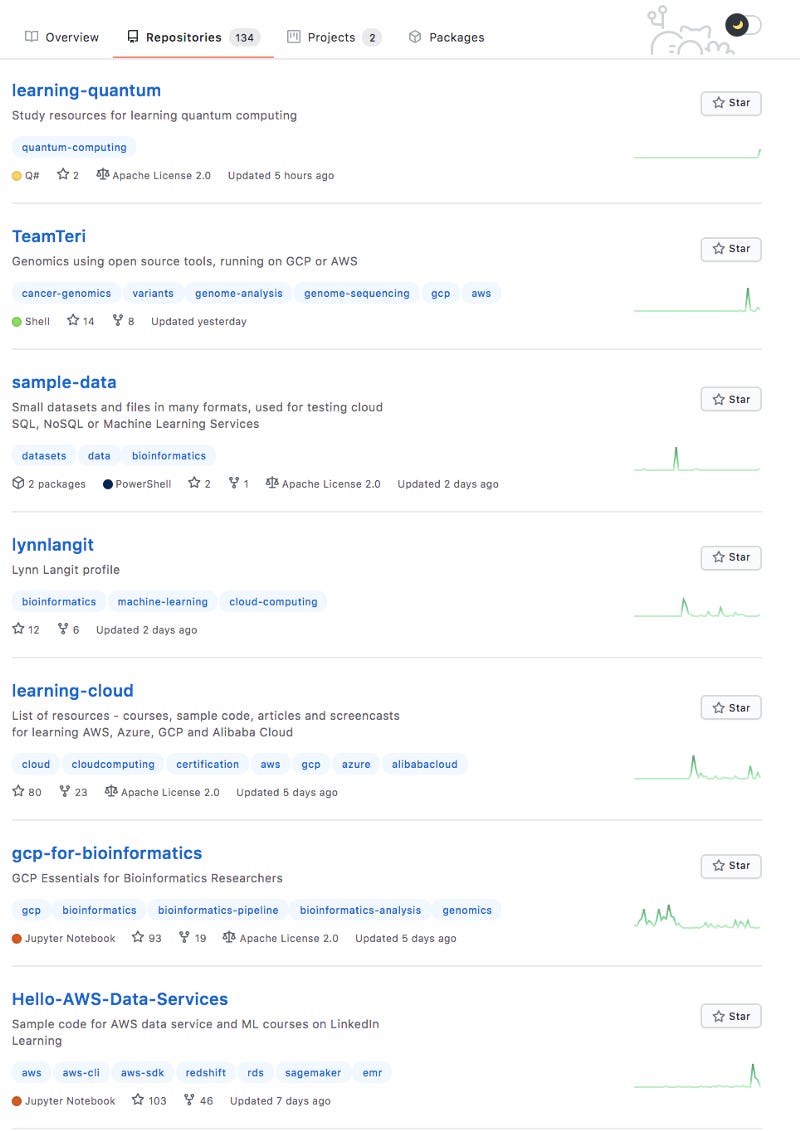Reflecting and looking forward after a year of daily GitHub contributions
Learning as a Serial Monogamist
I tend to do each new-to-me thing for about a year at a time. Lifelong learning is my way. Fun fact: I’ve never owned a TV.
For example, there was the year, when I did all of the then-available Khan Academy Math (~500 lessons). I ‘did math’ every day for a few hours for that entire year. I learned calculus at age 51 — so much joy.
Then there was the year when I delivered technical keynote talks all over the world — in London, Hong Kong, Singapore, Sydney, Vilnius and…I can’t remember where else, so many airplanes, such a long time ago. Actually it was 2017, but given world events in 2020, it seems like a lifetime ago.
What did I do in 2020? I committed, that is made at least one contribution to open source on GitHub every day. On my birthday? Yes. On Christmas while in the North Woods? Yes. From the GitHub mobile app (if I didn’t have my laptop)? Yes. I pushed one or more commits to GitHub every day for 365 consecutive days, with nearly 2,000 contributions in total. The green graph of my activity is shown below.
Why do I have this kind of compulsive behavior? I am big believer in showing up and speaking up, again and again (and again!) when there is a big problem.
What is the big problem?
I find myself in a career that, although satisfying, leaves something significant to be desired. What might that be? Peers. Specifically female peers. Why, after 15 years in tech has there been little to no improvement in the ratio of men-to-women doing technical jobs? Why indeed.
I am now at the point where I want to leave a wide trail for others to follow.
So why a year of contributing to open source? For the same reason I did the other stuff (keynotes, etc…) — someone, some woman, has to do it, it might as well be me. What is the ratio of women who contribute to open source? Google says for GitHub — it’s a pathetic 5.4% of the total contributions. This is even worse than the percentage of female contributions to wikipedia (8.8%). Why?
I could talk about the myriad negatives of being a women in tech, but I’d rather not. I prefer to talk about what I learned while on this particular journey.
What did I learn?
I chose GitHub as my open source platform and I worked to learn as much as I could about my platform and its associated tools. Some discoveries along the way…
GitHub Codespaces → browser-based IDE. I wrote some tips on Dev.to about my experience setting up custom Codespaces for my customers.
GitHub Actions, Releases and Packages → I tried these features out on my repo with ‘sample data’
Github Profiles → I created a short course on LinkedIn Learning‘Create a Great GitHub Profile’ and a repo with tips ‘great-github-profiles’
GitHub Desktop → while I can (and do) use the
gitcommand line, I also use the GUI for GitHub. One of my favorite features is image diff; an example is shown below.
What did I contribute?
Some of my contributions were very small (single lines of code, correction of typos, adding a sentence to documentation), but some were not. Creations that I am proud of include the following:
Created open source courses → ‘gcp-for-bioinformatics’ &‘learn-wdl’,
Left learning trails → ‘TeamTeri’ & ‘learning-quantum’
Added resources for my most popular LI_L courses → ‘gcp-essentials’ & ‘hello-aws-data-services’
So little time, so many repositories. Shown below is a short list of repos which reflects what I am working on /thinking about lately…
Sobering Reality
Data is useful. Here are some highlights from a well-written article about the overall problem of the lack of women in tech— https://www.dreamhost.com/blog/state-of-women-in-tech/
Current Status
- women hold only 26% of computing jobs, which is also steadily declining
- women’s tech job turnover rate is 2x as high than it is for men — 41% vs. 17%
- mid-career tech women leave their employers at a rate of 56%
WIT and Startups
12% of engineers at Silicon Valley startups are women. 11% of executive positions in Silicon Valley companies are held by women. 5% of leadership positions in the tech sector are held by women; they make up only 9% of partners at the top 100 venture capital firms. More than 20% of women over the age of 35 are still in junior positions.
Despite the fact that women-led companies (including startups) have historically performed 3x better than those with male CEOs and that venture-backed companies which were acquired most often had a 7% share of female execs, as opposed to 3% at unacquired firms, female-led companies get less funding.
In 2019, women-led companies received $3.3 billion in investments from venture capitalists, which is significantly lower than men and representing only 2.8% of total capital invested in startups. On average, women-operated, VC-backed tech startups generate annual revenues that are 12% higher than male-operated tech startups. Of nearly 22,000 publicly traded companies, those with more women in their leadership ranks were more profitable.
What’s next?
It’s time to work on getting technical women founders the equity they deserve. For my next journey, in 2021 I will take my seat at the table, becoming one of the first angel investors in a new fund (Groove Capital) which will accelerate first check investments in Minnesota startups.
I will continue to provide advisory to the Stanford StartX-backed team at CarbonDown. Also I will be shortly joining the board of a crypto startup. Here is my profile on AngelList.
Additionally, I’ve recently also made my first investment on republic.co (shown below) in Arlan Hamilton’s Backstage Capital fund.
I’ll be writing about my journey into advising and investing as I learn and do more. Follow me here on Medium and on Twitter to join my journey.








